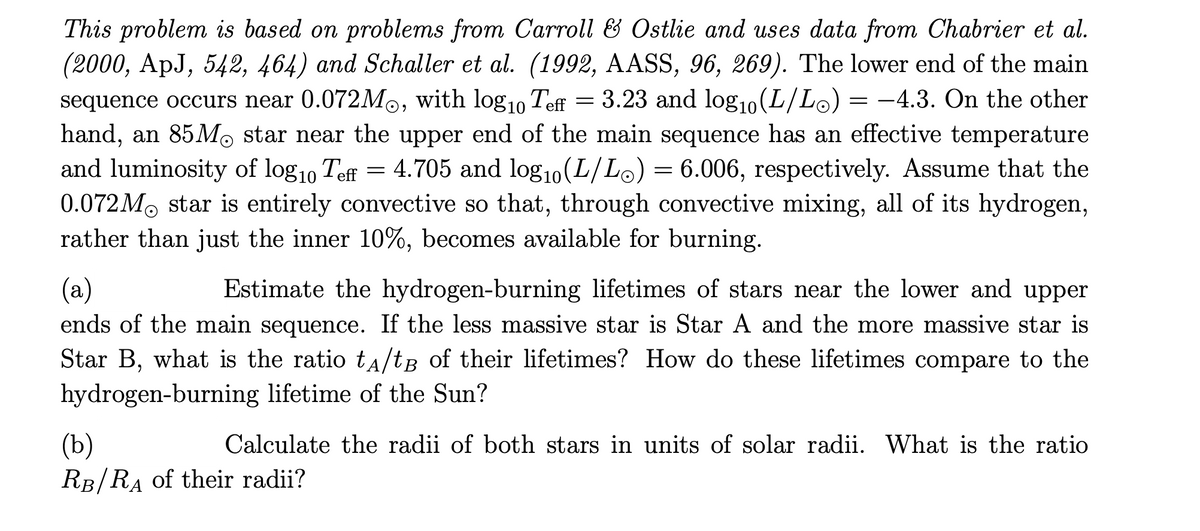This problem is based on problems from Carroll & Ostlie and uses data from Chabrier et al. (2000, ApJ, 542, 464) and Schaller et al. (1992, AASS, 96, 269). The lower end of the main sequence occurs near 0.072M0, with logj0 Teff hand, an 85Mo star near the upper end of the main sequence has an effective temperature and luminosity of log10 Teff = 4.705 and log10(L/Lo) = 6.006, respectively. Assume that the 0.072M. star is entirely convective so that, through convective mixing, all of its hydrogen, rather than just the inner 10%, becomes available for burning. = 3.23 and log10(L/Lo) = -4.3. On the other (a) ends of the main sequence. If the less massive star is Star A and the more massive star is Estimate the hydrogen-burning lifetimes of stars near the lower and upper Star B, what is the ratio ta/tg of their lifetimes? How do these lifetimes compare to the hydrogen-burning lifetime of the Sun? (b) RB/RA of their radii? Calculate the radii of both stars in units of solar radii. What is the ratio
This problem is based on problems from Carroll & Ostlie and uses data from Chabrier et al. (2000, ApJ, 542, 464) and Schaller et al. (1992, AASS, 96, 269). The lower end of the main sequence occurs near 0.072M0, with logj0 Teff hand, an 85Mo star near the upper end of the main sequence has an effective temperature and luminosity of log10 Teff = 4.705 and log10(L/Lo) = 6.006, respectively. Assume that the 0.072M. star is entirely convective so that, through convective mixing, all of its hydrogen, rather than just the inner 10%, becomes available for burning. = 3.23 and log10(L/Lo) = -4.3. On the other (a) ends of the main sequence. If the less massive star is Star A and the more massive star is Estimate the hydrogen-burning lifetimes of stars near the lower and upper Star B, what is the ratio ta/tg of their lifetimes? How do these lifetimes compare to the hydrogen-burning lifetime of the Sun? (b) RB/RA of their radii? Calculate the radii of both stars in units of solar radii. What is the ratio
Related questions
Question

Transcribed Image Text:This problem is based on problems from Carroll & Ostlie and uses data from Chabrier et al.
(2000, ApJ, 542, 464) and Schaller et al. (1992, AASS, 96, 269). The lower end of the main
= 3.23 and log1o(L/Lo) = -4.3. On the other
sequence occurs near 0.072M0, with log10 Teff
hand, an 85MO star near the upper end of the main sequence has an effective temperature
and luminosity of log10 Teff = 4.705 and log10(L/Lo) = 6.006, respectively. Assume that the
0.072M. star is entirely convective so that, through convective mixing, all of its hydrogen,
rather than just the inner 10%, becomes available for burning.
(a)
ends of the main sequence. If the less massive star is Star A and the more massive star is
Star B, what is the ratio tA/tB of their lifetimes? How do these lifetimes compare to the
Estimate the hydrogen-burning lifetimes of stars near the lower and upper
hydrogen-burning lifetime of the Sun?
(b)
RB/RA of their radii?
Calculate the radii of both stars in units of solar radii. What is the ratio
Expert Solution
This question has been solved!
Explore an expertly crafted, step-by-step solution for a thorough understanding of key concepts.
This is a popular solution!
Trending now
This is a popular solution!
Step by step
Solved in 8 steps
